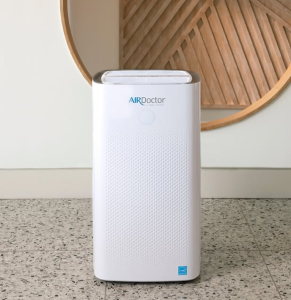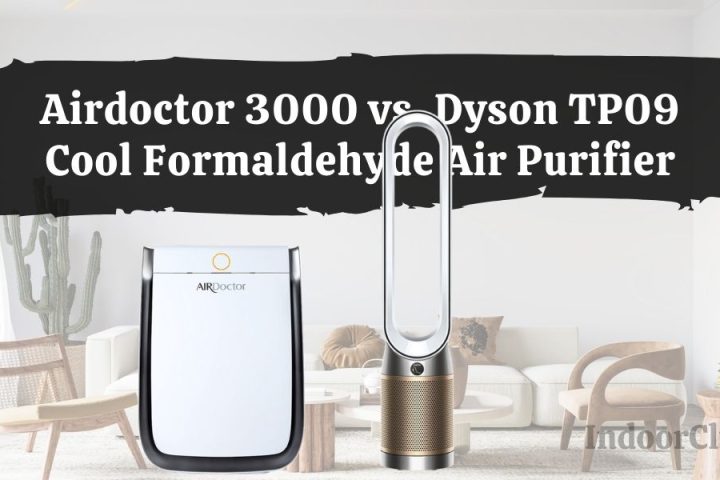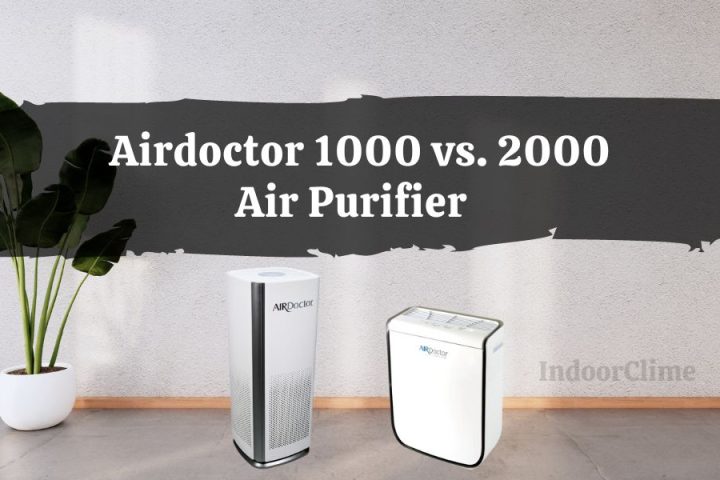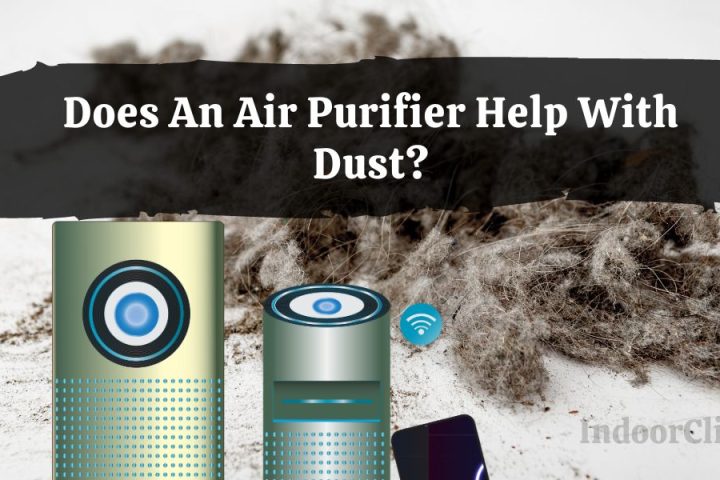If you’re wondering whether the Jaspr Air Scrubber is worth its steep price tag, you’re not alone, I was in the same position.
After reading a mix of enthusiastic and skeptical reviews, and seeing how many people mentioned better sleep, less snoring, or cleaner-smelling homes, I finally decided to test Jaspr for a full month to see if there’s anything behind the hype.
Now that I’ve lived with it day and night, in multiple rooms, through cooking sessions, perfumes, dust, and everyday life, here’s my honest, no-nonsense review.

The Jaspr Air Scrubber definitely positions itself as a premium, design-focused purifier with real performance behind it.
The steel construction, the clean top-mounted display, and the highly sensitive air-quality sensors give it a more serious, appliance-like presence than most plastic purifiers I’ve used. It feels like something built to last, not a gadget you replace every couple of years.
That said, the premium design and strong performance do come with a price. The machine itself isn’t cheap, and the filter replacements add a significant ongoing cost each year.
Jaspr clearly aims to be a long-term, high-end solution — but you have to be prepared for the long-term investment that comes with it.
Pros
Cons
What Is the Jaspr Air Purifier? (And Why They Call It an “Air Scrubber”)
Jaspr technically markets itself as an air scrubber, not just a purifier.
The main difference is airflow: air scrubbers are built to move a lot of air quickly, similar to what you’d see in commercial or professional settings.
Instead of gently circulating air in small rooms, Jaspr is designed to cycle the air in large spaces multiple times per hour.
In practice, this means it reacts almost immediately to anything in the air—smoke, perfume, cooking fumes, dust, or chemical smells.
That fast response is part of what sets it apart from typical consumer purifiers.
Why I Bought It (And How I Tested It)

The more reviews I read, the more curious I got. Dozens of people talked about:
- Sleeping better on night one
- Snoring improving
- Perfume or hairspray triggering the unit instantly
- Cooking smells disappearing faster
- Kids with allergies breathing better
- Cleaner air that you can “feel,” not just measure
Some of the claims sounded exaggerated, but hundreds of consistent reviews were hard to ignore.
So I bought it and tested it in three parts of my home:
- Living room (large open space) – where airflow challenges are obvious
- Bedroom – to test sleep, morning stuffiness, and snoring
- Kitchen area – to see how fast it reacts to cooking
I ran it mostly in Smart Mode since that’s how most people would realistically use it.
Design, Size & Build Quality

The first thing I noticed about the Jaspr is that it’s definitely larger and heavier than the typical purifier you’d find in a store.
It’s a tall, clean-looking cylinder, and because the body is made from cold-rolled steel instead of plastic, it immediately feels more like a proper home appliance than a gadget.
It has some weight to it—not enough to make it difficult to move, but definitely not something you’ll be carrying from room to room every day.
Size & Weight
- Tall cylinder shape, visually modern
- Weighs around 25 lbs (11 kg) – sturdy but not easily moved around
- No wheels, but you can tilt and slide it
Visually, it fits surprisingly well in my space. I’ve had it in both the living room and bedroom, and in both spots it blended in nicely.
The top vent is designed so the air is pushed out evenly in all directions, which makes it feel less like there’s a “blast” of air coming at you and more like the room is quietly circulating.
On the front, the round digital screen is clean and easy to understand. You get a live PM2.5 reading at all times, and the color ring around the screen shifts from green to yellow to red depending on air quality, so you can glance at it from across the room and immediately know what’s going on.
It’s honestly one of the few purifiers I’ve seen that looks better in person than in the product photos—minimalist, modern, and not cheap-looking at all.
Interface
- Beautiful circular screen
- Real-time PM2.5 readings
- Color-coded air-quality ring
- Intuitive buttons
- Looks like a high-end home appliance, not a medical device
This thing genuinely looks like it belongs in an Apple Store.
Performance: What the Jaspr Is Actually Capable Of

This is where Jaspr stands out. It’s not subtle—it moves a lot of air, and you feel it.
Filtration
Jaspr uses a 3-stage system:
- Pre-filter – traps hair, pet dander, large dust
- True HEPA – captures 99.97% of particles down to 0.3 microns
- Activated carbon – removes odors, VOCs, smoke, gases
The carbon amount is less than some industrial machines, but performance still impressed me.
CADR & Airflow
While the company doesn’t publish exact CADR numbers publicly, independent reviewers estimate it around 320–350+, which matches how it behaves in real life.
Jaspr often advertises that it can handle “up to 1,600 square feet,” which sounds impressive—and technically, that number isn’t wrong, but it needs context.
If you look at the more realistic measurement of 4 air changes per hour (ACH) at standard 8-foot ceilings, the effective coverage comes out to around 638 square feet.
That number actually makes more sense in real life. In my house, it performs extremely well in medium-to-large rooms—living rooms, open hallways, bedrooms, and connected spaces.
It can reach into larger areas, but the air cleaning is strongest when the room is in that 500–650 sq. ft. range.
So the marketing number isn’t exactly false, but the real-world sweet spot is smaller.
Still, for a purifier its size, the performance is excellent, especially because it pushes air so aggressively that it feels like it’s “reaching” beyond the room it’s in.
In my home:
- It cycles the air in my bedroom noticeably quickly
- Air quality changes from cooking or dust are picked up instantly
- When I sprayed cologne in the hallway, the machine went from green to orange in under a second.
Real-World Impact
Here are the actual changes I noticed after a month:
- Morning air feels lighter and cleaner
- Cooking smells disappear faster than before
- Air quality stays consistently low (PM2.5 between 002–006)
- My sleep improved—not dramatically, but clearly
- Less morning congestion
- It handles open spaces better than any consumer purifier I’ve owned
I also noticed something many reviewers mentioned: the air feels “fresher,” in a way that’s hard to measure but easy to feel.
Power Consumption & Noise Level
In terms of noise, Jaspr runs somewhere between 33 and 58 decibels, depending on the fan speed.
On the lowest levels, I can barely hear it. It’s more of a soft air movement sound than actual noise, and in day-to-day use I don’t even notice it running in the background.
But when I start cooking—especially frying or using anything that produces smoke or strong smells—the fan kicks up automatically.
At that point, you can definitely hear it, but it’s not annoying or disruptive. Honestly, it’s reassuring.
A purifier can’t silently move that much air; airflow always creates some sound. So when it gets louder, it’s almost like the machine is telling you, “Okay, let me handle this.”
Night mode has been one of my favorite features. When I set it to night mode, the screen turns off completely and the fan drops to a very soft, consistent level.
It’s quiet enough that I don’t think about it at all, even when I’m falling asleep. After the first night, I genuinely forgot it was even there.
As for power consumption, Jaspr uses around 30 watts on its lowest speed and can go up to about 90 watts at full power.
For a purifier this large—and one that moves this much air—that’s actually quite reasonable.
Most of the time it stays on the lower end anyway, since it only ramps up when something triggers it. So in daily use, energy use hasn’t been a concern at all.
This is not a cheap purifier—but it is energy efficient.
Maintenance & Filter Costs

Jaspr uses one large 3-in-1 filter—the pre-filter, the H12 HEPA layer, and about one pound of activated carbon are all housed together.
It’s a simple setup, and replacing it takes less than a minute, but the cost is something you definitely notice.
The company recommends swapping the filter every six months.
They openly admit that the HEPA portion could last longer, but the carbon layer is what gets saturated first, and once the carbon is “used up,” odors and VOCs aren’t filtered as effectively.
So their six-month schedule is really about keeping the purifier running at its best rather than squeezing every last day out of the filter.
Price-wise, here’s where things get real:
- If you buy a single replacement filter, it costs $299.
- If you join their “Filter Club” subscription, it drops to $199 every six months.
- And joining the subscription also happens to be what maintains the lifetime warranty, which feels a bit strategic on their part.
So depending on which route you take, the yearly cost looks like this:
- With subscription: about $398 per year
- Without subscription: about $598 per year, and you lose the lifetime warranty
It’s not cheap. This is probably the biggest ongoing expense of owning the Jaspr, and honestly, it’s something to think about before buying.
On the other hand, the filter is huge compared to what most consumer purifiers use, and a pound of carbon in a home unit is actually more than average. So you are paying for a bigger, heavier-duty filtration system.
In my experience, the performance is strong enough that I don’t feel like the money is wasted—but I’d be lying if I said the filter cost wasn’t a factor you’ll feel each year.
This is the part of the product that clearly puts Jaspr in the “premium” category, both in build and in long-term ownership.
How Jaspr Compares to Other Premium Purifiers
| Air Purifier | Jaspr Air | Air Doctor 5500i | Dyson BP04 | MOUNTO HEPA500 | Blue Pure 211i Max |
| Room Size Coverage | 638 sq. ft. 4x/hour | 1085 sq. ft. 4x/hour | ~400 sq. ft. 4x/hour | 1200 sq. ft. 4x/hour | 762 sq. ft. 4x/hour |
| CADR (Smoke)/CFM | 340 | 534 | 185 | 550 | 410 |
| Noise Level | 33 – 58 dB | 30 – 50 dB | 33 – 56 dB | 55 – 70 dB | 23 – 53 dB |
| Dimensions | 11.5” (W) x 11.5” (D) x 31.5” (H) | 16″ (W) x 16″ (D) x 28.75″ (H) | 16.3” (W) x 17.1” (D) x 32.7” (H) | 25” (W) x 25” (D) x 16” (H) | 14.4” (W) x 14.4” (D) x 22.7” (H) |
| Weight | 25 lbs | 33 lbs | 26 lbs | 40 lbs | 16.2 lbs |
| Price | Check Here | Check Here | Check Here | Check Here | Check Here |
I’ve tested or owned several high-end air purifiers over the years, and before buying Jaspr, I did a lot of comparison shopping.
Below is how it stacks up against a few major competitors — not just in specs, but in real-world practicality.
Jaspr vs. AirDoctor 5500 Air Purifier
The AirDoctor 5500 is a genuinely strong machine, and in terms of raw cleaning power, it performs in the same league as Jaspr. But living with it feels different.
One thing that surprised me is that the large front panel on the AirDoctor looks like it should pull air in — but it doesn’t. The actual air inlets are only on the sides, which means you must leave a full foot of space on both sides for proper airflow.
In a normal home, that limits where you can realistically put it. Jaspr, on the other hand, has a 360-degree air inlet, so placement is much easier.
There’s also a noticeable difference in materials. The AirDoctor is made from shiny ABS plastic — the kind that reflects light and shows every fingerprint.
It feels more lightweight and less premium, and from an environmental standpoint, ABS plastic production emits significantly more CO₂ than rolled steel. Jaspr’s metal body feels like a real appliance designed to last.
Maintenance is another difference. AirDoctor uses separate filters (pre, HEPA, carbon), which means you can replace them at different intervals. Over a couple of years, that can save you money — especially since HEPA filters often last 12–24 months, while carbon typically lasts 6–12 months.
With Jaspr, the entire 3-in-1 filter must be replaced every six months, which makes ownership simpler, but more expensive.
AirDoctor 5500 can handle 1,085 sq ft at 4 air changes per hour, which is significantly more coverage than the Jaspr offers at the same ACH. On paper, that makes the 5500 one of the strongest home-focused machines in its class, especially if you have a big open-concept living space.
On price, the AirDoctor 5500 officially retails for $999, but the reality is that AirDoctor is almost always running aggressive sales.
It’s common to see it offered for hundreds less than the list price, which means you can often buy the 5500 at a noticeably cheaper price than Jaspr — sometimes dramatically cheaper.
If you’re shopping during one of their deals, the value proposition becomes even stronger.
That said, performance isn’t the only factor. The AirDoctor still uses a glossy ABS plastic body, pulls air only from the sides, and requires a full foot of clearance on both sides just to operate efficiently.
You also need to clean the pre-filter regularly, and while the separate filters can save you money in the long run, the overall experience feels more “appliance-like” and less premium compared to Jaspr’s steel construction and 360-degree air intake.
If raw coverage at 4 ACH is your top priority — and especially if you catch the 5500 on sale — it’s a very compelling alternative. But if build quality, easier placement, and a more refined design matter to you, Jaspr still wins on the overall experience.
We’ve already compared Jaspr to the AirDoctor 4000 earlier — you can read that breakdown in the dedicated section.
Jaspr vs. Dyson BP04 Air Purifier
I’ve owned my share of Dyson products, and I’ve learned to admire the design while being disappointed by the performance.
With their air purifiers, the biggest concern is the actual cleaning power — Dyson simply doesn’t publish CADR numbers.
Using Dyson’s airflow ratings, reviewers have reverse-engineered the estimated CADR of their flagship model (the Purifier Big+Quiet Formaldehyde BP04) to be around 184 CFM.
That’s extremely low for a purifier that costs around $1,100, especially when compared to machines built for large spaces.
To be fair, Dyson does a good job at tackling VOCs like formaldehyde, and Jaspr also handles VOCs extremely well.
But the Dyson just doesn’t move enough air to be competitive in larger rooms or open homes.
If I’m spending that kind of money, I want performance, not just attractive design and a tall fan tower.
For the price, Dyson wouldn’t be my first choice — especially not over Jaspr.
Jaspr vs. MOUNTO HEPA500 Commercial Air Scrubber

This one is interesting because the MOUNTO HEPA500 is a commercial air scrubber — a machine designed for construction sites, water damage restoration, and job sites that need aggressive air cleaning. It’s powerful, rugged, and much louder than anything made for a home.
It can push up to 500 CFM, which absolutely beats Jaspr in airflow. But it’s also a roto-molded plastic brick with handles, a daisy-chainable outlet, and a prominent filter-change light. It’s perfect for contractors and disaster recovery crews, not for a living room or a bedroom.
It’s bulky, noisy, and has a very industrial look. You can use it at home, but it’s overkill unless you’re renovating or dealing with serious contamination. Jaspr is far quieter, far more attractive, and designed for continuous use in a home environment.
If you need massive airflow and don’t care about noise, the MOUNTO is incredible for the price.
If you want something that cleans air without sounding like shop equipment, Jaspr wins easily.
Jaspr vs. Blueair 211i Max Air Purifier

Blueair’s Pure Max line is one of the best-performing consumer purifiers available, and the 211i Max is a strong competitor.
Blueair advertises huge coverage areas — up to 762 sq. ft 4x per hour on high — and thanks to their HEPASilent dual filtration technology, they manage fast cleaning with surprisingly low noise (23–53 dB).
In real life, Blueair is impressive for its size and price. It’s lighter, quieter, and cleans medium-to-large rooms extremely well. The smart app is more advanced than Jaspr’s too, with scheduling, geofencing, and better air-quality analytics.
However, Blueair units are still primarily plastic, and while the airflow is high, the compression-style fans aren’t as forceful as Jaspr’s turbine setup.
Blueair is fantastic value and one of the best choices under $500–$600, but it doesn’t quite match the “heavy-duty air scrubber” performance of Jaspr.
If your priority is quiet, efficient, app-friendly cleaning at a good price, Blueair is excellent.
If you want maximum airflow and faster reaction to pollutants, Jaspr feels stronger.
Final Comparison Verdict
Here’s the simplest way I’d summarize everything after testing and researching them:
- Blueair is excellent consumer purifiers.
- Dyson is mostly paying for design.
- AirDoctor is a solid competitor but still plastic and less flexible in placement.
- MOUNTO is for construction sites, not homes.
- Jaspr sits in its own category:
a premium, steel-built air scrubber with serious airflow, fast responsiveness, and home-friendly noise levels.
If you want the strongest purifier under $1,200 that still looks good in a house, Jaspr is the one that stands out.
Final Thoughts: Is Jaspr Worth the Investment?

Whether Jaspr is the right choice really comes down to what you expect from an air purifier—and how demanding your home environment is.
After using it daily for a month, here’s the simplest way I can put it: Jaspr is absolutely worth it if you need serious air cleaning power, not just a small-room purifier that gently freshens the air.
If you live in a house with open rooms, high ceilings, pets, dust, cooking smells, or any kind of airflow challenges, Jaspr feels noticeably stronger than the typical purifiers you see in big-box stores.
It reacts faster, moves more air, and seems to “clean” the whole room rather than just the space immediately around it. I saw real differences in sleep quality, morning stuffiness, and how quickly odors disappeared—things that cheaper purifiers simply don’t manage as well.
But it’s not for everyone. The upfront price is high, and the filter subscription adds a recurring cost you’ll definitely feel every year.
If you only need a purifier for a small bedroom or occasional use, Jaspr might be more machine than you realistically need.
However, if you want something that performs closer to a professional air scrubber—something that actually changes the way the air in your home feels and smells—then Jaspr is one of the strongest options I’ve tested. It’s the only purifier I’ve used that feels built for a real house, not just a small enclosed room.
In short: Buy Jaspr if you want top-tier performance and you’re okay with the long-term cost. Skip it if you’re looking for a budget-friendly or occasional-use purifier.







